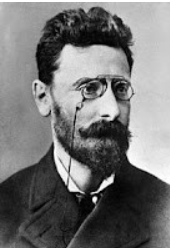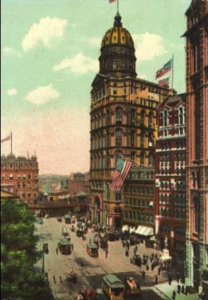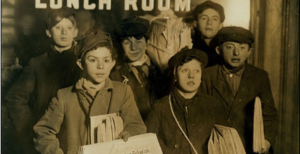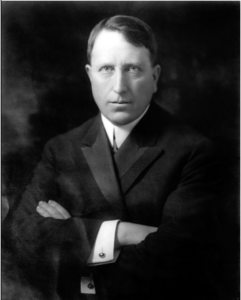April 7, 2024
STRIKE! The Newsies versus Pulitzer and “The World”

August 2nd, 1899 – Joseph Pulitzer had a decision to make. His newspaper syndicate, The World, had been beseiged by the largest labor strike it had ever seen. Its paper sales dropped by two-fifths over the course of six days and its loss of circulation was continuing to climb. He had been advised by his managing editor that The World‘s advertisers were beginning to pull their ads from circulation, and New York’s police chief had been unsuccessful in curtailing those responsible for this hinderance to New York’s largest paper publisher.1 With mounting financial pressures and the need to maintain a positive public image, Pulitzer would be forced to choose: Negotiate with his rebellious workers, or stick it out until they could be broken. So how did Pulitzer find himself in this precarious situation? And what exactly were his workers striking for?

To understand this event, we must first understand Joseph Pulitzer’s rise in success within the publishing industry. Pulitzer was from a Jewish and Hungarian background, having emigrated to the U.S. in his younger years from Europe, and would serve in the northern army during the American Civil War (1861-1865). After the war, Pulitzer would eventually end up in St. Louis, Missouri, a subsequent haven for Germans and German-speakers due to the high influx of German immigrants several decades before. There, Pulitzer would have trouble holding down a job, and was often between jobs for the next several years, until he decided to try publishing an account of his misadventures in the German-language daily paper Die Westliche Post. Fortunately for Pulitzer, the editors of the paper liked his story and had decided to publish it around March of 1867. This first publishing success for Pulitzer would open new avenues for Pulitzer to follow via his new friends at the Westliche Post. Pulitzer would first meet two attorneys by the names Patrick and Phillip, who would help Pulitzer find a position as a deed counter for the APR (Atlantic-Pacific Railroad), and would also allow Pulitzer access to their library to help him study for the bar exam. Pulitzer would then try his hand at politics, joining the Republican Party in 1870 and serving as a delegate for the party until 1876, at which point he became disillusioned by the party’s motives after the controversial election of 1876 and the ascension of Rutherford B. Hayes to the presidency.2
While Pulitzer had walked away from this more cynical than he had been before, but it had given him the capital and the social clout to be able to purchase the St. Louis Dispatch in 1878, and merge it with the other contemporary newspaper publisher, the St. Louis Post and Dispatch, creating the Post-Dispatch in St. Louis. Pulitzer would go onto successfully operate and grow the subscription rates for new newspaper dispatch, and it would be here that Pulitzer would begin to utilize the technique of “Sensationalism” within his journalism. Broadly defined as a focus on topics of a controversial or taboo nature (violent crimes, public tragedies, sex scandals), sensationalism was a journalistic practice that sought to capitalize on the public’s interest concerning those topics, and Pulitzer found much success in marketing his papers with exaggerated, and sometimes salacious, headlines. While Pulitzer did not invent the practice of “Sensationalism”, and was definitely not the first to utilize it, he was the most successful at utilizing it. And the Post-Dispatch newspaper would become the biggest in St. Louis, having grown its subscriptions having grown from around 4,000 members, to over 22,000 towards the latter half of 1882. But his success was only going to get bigger. 3
In May of 1883, Pulitzer would purchase the New York World from the financier Jay Gould, in the hopes of turning its lackluster and down-trodden fortunes around, moving to New York with his wife to oversee its operations. Beginning that same month, Pulitzer began to revitalize The World, and realized that if he wanted to compete in New York’s newspaper business, he would need to appeal to the most number of people possible. And to do that, he would have to devise new and clever ways to gain their interest. This interest group would consist of immigrants and working-class individuals, often lower-class, whom Pulitzer surmised would be ample targets for his headlines. And in order to market to this audience, Pulitzer utilized three separate tactics: 1) Sensationalist headlines that draw in attention, 2) Large formatted pictures, and 3) Shorter, more numerous articles within each paper. 4

The first tactic was, of course, Pulitzer’s primary tool in his publishing workshop and purchased him the attention that The World desperately needed to compete in the publishing market. The second tactic had the intention of appealing to those individuals who understood little to no English, giving them a visual depiction of the headline that day. It also marked an early instance of news being presented more visually, rather than literarily, in American mass media, something that Pulitzer would capitalize heavily on in his publications. The third tactic was a rather ingenious piece of formatting on Pulitzer’s part and can be seen as an adaptation to the changing pace of American life at the time. With the incorporation of trolleys and railway systems within New York, the average person’s commute to and from their workplace was shortened, meaning that their time to read that day’s headlines was also shortened. To work around this time constraint, Pulitzer decided to restructure his newspapers articles to favor shorter, livelier stories so that the reader could consume more (ideally) entertaining, short-form, and (not always) informative content. 5
These changes would garner Pulitzer the success he desired, and by May of 1885, just two years after he had purchased The World, he would grow its subscriptions from 15,700 subscribers to 153, 200 subscribers, a ten-fold increase. This jump in both popularity and support from the New York populace would set the record for the fastest growing newspaper in the New York at the time, and would secure Pulitzer’s place at the top of New York’s newspaper scene into the 20th century. With Pulitzer on top of The World, it seemed like nothing could stop its growth. And indeed, Pulitzer would not expect the rude awakening to come from far below his ambitious gaze6
As it happened, the growth of The World did not come about due to Pulitzer’s ideas alone. It involved, by-and-large, child labor in the distribution process of the daily papers on the streets of New York City. The children responsible for this distribution were called Newsies, and consisted of both boys and girls (mostly boys) whose ages ranged from pre-teens to eighteen and nineteen year olds who sold papers for virtually every single major media publisher in New York at the time. The payment process between the newsies and the publishers worked as follows: Each newsie would purchase 100 papers for around 50 cents a stack. It would then be each newsie’s job to sell every paper to make up for the amount they had paid for the stack, with no reimbursement for their unsold copies. This system would lead to fighting between newsies for ideal corners to sell on, and many of them faced harassment and muggings on the streets from both strangers and other newsies. The vast majority of the newsies were also homeless, and would roam New York’s streets when they weren’t busy selling their papers. On top of homelessness, the lack of adequate clothing for the winter months and proper sanitation remained a chronic issue for most newsies during this time.7

In today’s context, this type of child labor (or any child labor for that matter) would be highly illegal and would warrant fines levied on those employing the services of children. But two such caveats prevented any legal action from being taken against The World or any other paper distributor at the time. The first is that U.S. child labor laws, while they did exist at the time, were not sufficient enough to put an end to the vast system of child exploitation in and around the New York City area at the time. The second caveat is that the majority of newsies were considered “Independent Contractors” that worked for the newspapers, and were not considered “employees” per se in the eyes of the newspapers themselves. This meant that the newspapers, although they heavily relied on newsie labor, assumed no responsibility for their working or living conditions. 8 However, this also meant that the profits of the newspapers depended on the sales of the newsies. If the newsies sold their papers, the newspapers profited, and if they didn’t, the newspapers took a loss. This dynamic would eventually come to a head in the summer of 1899.
Now, the year before the strike would occur, the two most successful newspapers in New York City were battling it out over who could capitalize the most on information (or rather, sensation) regarding the Spanish-American War (April 21 – December 10, 1898) circulating throughout the U.S. at the time. The fight would be between Pulitzer’s World and William Randolph Herst’s New York Journal over who could dominate the headlines. With the war raging, both publishers decided to take advantage of the public’s interest for news about the war, and they decided to increase the cost of the newsies’ paper stacks from 50 cents to 60 cents. This move would guarantee Herst and Pulitzer would reap an immediate monetary increase from their sales, and meant that the newsies would now have to sell ten percent more of their papers to cover just the cost of buying them. While the move wasn’t popular, most newsies abided by it as the war was still happening and the denizens of New York City were still buying papers with its headlines. This attitude towards the war, however, would begin to fade by the spring and early summer of 1899, and by July many newsies were calling on both Herst and Pulitzer to lower the buying price back to 50 cents. Herst and Pulitzer would refuse. What would ensue next caught not just Pulitzer and Herst off guard, but almost all of New York City paused for a moment to witness the largest child-labor strike of its history take place. 9

The Newsies Strike of 1899, as it would later be called, began on July 19 and saw around 5,000 newsies of all ages throw down their stacks of papers and refuse to sell them unless the buying price was lowered. The strike spanned across not just New York City itself, but areas of Massachusetts, Connecticut, and Rhode Island all saw newsies throw down their papers in protest as well.10 The newsies wasted no time in preventing any scabs (replacement workers) from selling any more papers, and would clash several times with local law enforcement who tried to break up the strike. The strike would reach its high point when the newsies gathered for a rally of solidarity on July 24 in New Irving Hall. With around 2,000 newsies inside, and another 3,000 crowded outside the hall, several local politicians, a union committee, and reporters from the New York Times would come to the rally and express their sympathies for the newsies in their endeavours. 11
After a week more of newsie protesting, both Herst and Pulitzer could hold out no longer. The financial strain of halted labor, coupled with an increasingly negative picture being painted in the media (with Herst and Pulitzer as the villains), would ultimately cause both men to agree to a compromise on August 2, allowing the newsies to sell back their unsold copies to the newspapers if the stack price remained at 60 cents.12 This deal was deemed satisfactory by both sides, and the strike would end after 14 days. To this day, it remains the largest labor strike ever organized by a predominantly teenage demographic, and it highlighted just how much power child-laborers truly had over the businesses they worked for.
Within the context of the 20th century, the story of the newsie strike still lives on, not just as a part of labor history, but in the minds of contemporary Americans, with a musical aptly titled “Newsies!” crafting a dramatized retelling of the strike, and the struggle between mainly Pulitzer and the newsies over the fate of the The World. The overall impact of the strike showed the resourcefulness of children and teens living within the impoverished condition of late 19th century New York, and set an example for other newsies across America that they, too, had the ability to instill change in their environments.
- Gillespie, Judy. “Being and Becoming: Writing Children into Planning Theory.” Planning Theory 12, no. 1 (2013): 68. http://www.jstor.org/stable/26165917. ↵
- JAMES McGRATH Morris, “Man of the World,” The Wilson Quarterly (1976-) 34, no. 1 (2010): 28-29. ↵
- JUERGENS, GEORGE. “SENSATIONALISM.” In Joseph Pulitzer and the New York World, 43–92. Princeton University Press, 1966. http://www.jstor.org/stable/j.ctt183q2tb.6. ↵
- JUERGENS, GEORGE. “SENSATIONALISM.” In Joseph Pulitzer and the New York World, 43–47. Princeton University Press, 1966. http://www.jstor.org/stable/j.ctt183q2tb.6. ↵
- JUERGENS, GEORGE. “SENSATIONALISM.” In Joseph Pulitzer and the New York World, 43–48. Princeton University Press, 1966. http://www.jstor.org/stable/j.ctt183q2tb.6. ↵
- JUERGENS, GEORGE. “SENSATIONALISM.” In Joseph Pulitzer and the New York World, 50. Princeton University Press, 1966. http://www.jstor.org/stable/j.ctt183q2tb.6. ↵
- Rohs, Edward, and Judith Estrine. “New York City in the Nineteenth Century.” In Raised by the Church: Growing up in New York City’s Catholic Orphanages, 14. Fordham University Press, 2012. https://doi.org/10.2307/j.ctt13wzxsn.8. ↵
- Gillespie, Judy. “Being and Becoming: Writing Children into Planning Theory.” Planning Theory 12, no. 1 (2013): 69-70. http://www.jstor.org/stable/26165917. ↵
- Bekken, Jon. “Newsboys: The Exploitation of ‘Little Merchants’ by the Newspaper Industry.” In Newsworkers: Toward a History of the Rank and File, edited by Hanno Hardt and Brennen, NED-New edition., 208-209. University of Minnesota Press, 1995. http://www.jstor.org/stable/10.5749/j.ctttt8n4.11. ↵
- Gillespie, Judy. “Being and Becoming: Writing Children into Planning Theory.” Planning Theory 12, no. 1 (2013): 68. http://www.jstor.org/stable/26165917. ↵
- Bekken, Jon. “Newsboys: The Exploitation of ‘Little Merchants’ by the Newspaper Industry.” In Newsworkers: Toward a History of the Rank and File, edited by Hanno Hardt and Bonnie Brennen, NED-New edition., 209-210. University of Minnesota Press, 1995. http://www.jstor.org/stable/10.5749/j.ctttt8n4.11. ↵
- Bekken, Jon. “Newsboys: The Exploitation of ‘Little Merchants’ by the Newspaper Industry.” In Newsworkers: Toward a History of the Rank and File, edited by Hanno Hardt and Bonnie Brennen, NED-New edition., 209. University of Minnesota Press, 1995. http://www.jstor.org/stable/10.5749/j.ctttt8n4.11. ↵
Tags from the story
Nomination-Communication-Studies